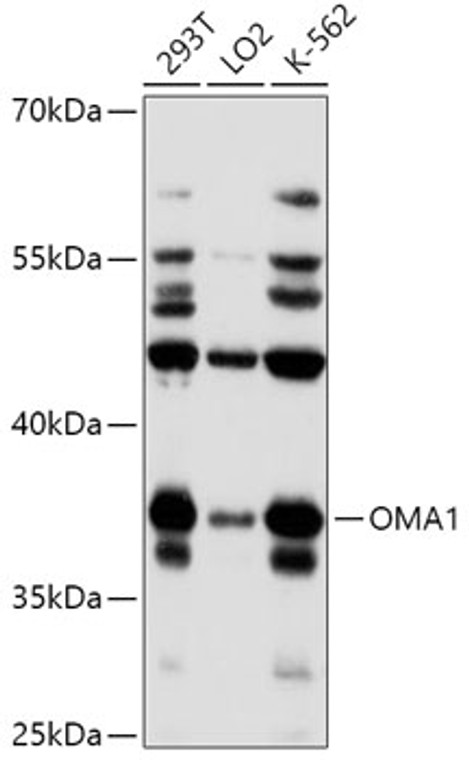| Host: |
Rabbit |
| Applications: |
WB |
| Reactivity: |
Human/Mouse/Rat |
| Note: |
STRICTLY FOR FURTHER SCIENTIFIC RESEARCH USE ONLY (RUO). MUST NOT TO BE USED IN DIAGNOSTIC OR THERAPEUTIC APPLICATIONS. |
| Short Description: |
Rabbit polyclonal antibody anti-OMA1 (360-524) is suitable for use in Western Blot research applications. |
| Clonality: |
Polyclonal |
| Conjugation: |
Unconjugated |
| Isotype: |
IgG |
| Formulation: |
PBS with 0.01% Thimerosal, 50% Glycerol, pH7.3. |
| Purification: |
Affinity purification |
| Dilution Range: |
WB 1:500-1:2000 |
| Storage Instruction: |
Store at-20°C for up to 1 year from the date of receipt, and avoid repeat freeze-thaw cycles. |
| Gene Symbol: |
OMA1 |
| Gene ID: |
115209 |
| Uniprot ID: |
OMA1_HUMAN |
| Immunogen Region: |
360-524 |
| Immunogen: |
Recombinant fusion protein containing a sequence corresponding to amino acids 360-524 of human OMA1 (NP_660286.1). |
| Immunogen Sequence: |
AICPRDSLALLCQWIQSKLQ EYMFNRPYSRKLEAEADKIG LLLAAKACADIRASSVFWQQ MEFVDSLHGQPKMPEWLSTH PSHGNRVEYLDRLIPQALKI REMCNCPPLSNPDPRLLFKL STKHFLEESEKEDLNITKKQ KMDTLPIQKQEQIPLTYIVE KRTGS |
| Tissue Specificity | Widely expressed, with strong expression in the heart, skeletal muscle, kidney and liver. |
| Post Translational Modifications | May form a redox-dependent disulfide bond. Exists in a semi-oxidized state and is activated by prolonged hypoxia. Autocatalytically cleaved in response to mitochondrial depolarization both at the N-terminus and C-terminus to generate the short active form (S-OMA1). Autocatalytic processing at the C-terminus takes place at residues 447-456. The S-OMA1 form is unstable. Degradaded by YMEL1 in response to membrane depolarization. Protein turnover is regulated by prohibitin (PHB and PHB2), which promotes degradation of OMA1 in a cardiolipin-binding manner. |
| Function | Metalloprotease that is part of the quality control system in the inner membrane of mitochondria. Activated in response to various mitochondrial stress, leading to the proteolytic cleavage of target proteins, such as OPA1, UQCC3 and DELE1. Following stress conditions that induce loss of mitochondrial membrane potential, mediates cleavage of OPA1 at S1 position, leading to OPA1 inactivation and negative regulation of mitochondrial fusion. Also acts as a regulator of apoptosis: upon BAK and BAX aggregation, mediates cleavage of OPA1, leading to the remodeling of mitochondrial cristae and allowing the release of cytochrome c from mitochondrial cristae. In depolarized mitochondria, may also act as a backup protease for PINK1 by mediating PINK1 cleavage and promoting its subsequent degradation by the proteasome. May also cleave UQCC3 in response to mitochondrial depolarization. Also acts as an activator of the integrated stress response (ISR): in response to mitochondrial stress, mediates cleavage of DELE1 to generate the processed form of DELE1 (S-DELE1), which translocates to the cytosol and activates EIF2AK1/HRI to trigger the ISR. Its role in mitochondrial quality control is essential for regulating lipid metabolism as well as to maintain body temperature and energy expenditure under cold-stress conditions. Binds cardiolipin, possibly regulating its protein turnover. Required for the stability of the respiratory supercomplexes. |
| Protein Name | Metalloendopeptidase Oma1 - MitochondrialMetalloprotease-Related Protein 1Mprp-1Overlapping With The M-Aaa Protease 1 Homolog |
| Database Links | Reactome: R-HSA-169911 |
| Cellular Localisation | Mitochondrion Inner MembraneSingle-Pass Membrane Protein |
| Alternative Antibody Names | Anti-Metalloendopeptidase Oma1 - Mitochondrial antibodyAnti-Metalloprotease-Related Protein 1 antibodyAnti-Mprp-1 antibodyAnti-Overlapping With The M-Aaa Protease 1 Homolog antibodyAnti-OMA1 antibodyAnti-MPRP1 antibody |
Information sourced from Uniprot.org
12 months for antibodies. 6 months for ELISA Kits. Please see website T&Cs for further guidance







